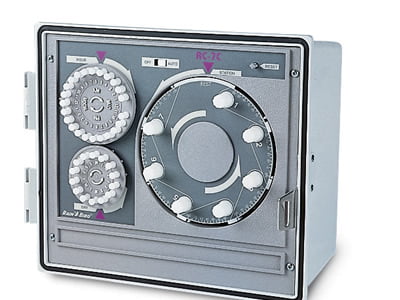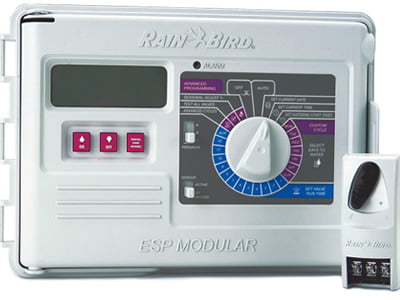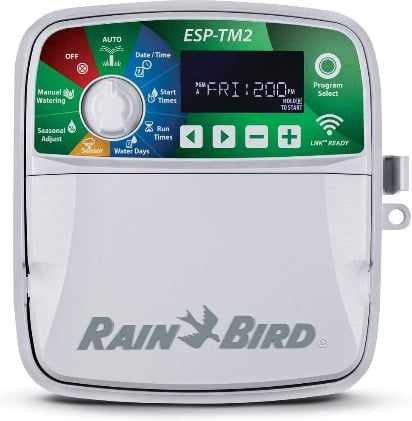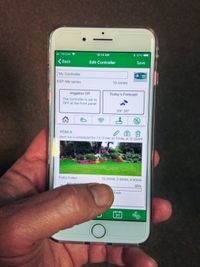What Controllers Do
Depending on the size of the property, landscape irrigation systems can have between one and one hundred different zones for water distribution. Each zone serves a different part of the property and is operated independently and sequentially for a specific interval each day or every few days.
Properly arrayed zones ensure that, after factoring for water pressure and irrigation method (e.g., drip hose, or spray or rotor sprinkler head), the right amount of water is delivered for the plant types and topography in each zone.
Automatic landscape irrigation system controllers are programmed to turn the water on and off in a specific sequence and for a preset period of time in each of your sprinkler system’s zones.
Types of Controllers
There are three types of automatic landscape irrigation controllers: mechanical, digital, and ‘smart’ WiFi-enabled. Controllers are weather-resistant and are usually placed in a garage or a convenient outdoor location.



Older systems that have not been upgraded have a gutter-mounted rain sensor and a clock-based mechanical controller with dials that are used to set watering days and times for each zone. Somewhat newer systems have a gutter-mounted rain sensor and a computerized digital controller that deliver the same outcomes as a mechanical controller. The newest and smartest systems have WiFi-compatible controllers or, if the property has a WiFi connection, active WiFi controllers.
 The biggest difference between the three types of controllers is that mechanical and computerized digital controllers must be operated at the controller location, while active WiFi controllers can be operated from anywhere using an app installed on a smart phone, tablet, or other WiFi connected device. Active WiFi controllers provide real-time alerts to issues with your system and send warnings when freezing conditions are anticipated so you can take appropriate action. Active WiFi controllers also allow your irrigation service company to remote into your system for check-ups on a regular basis to identify potential problems before they become actual problems (e.g., malfunctioning sprinkler heads, inactive zones, leaky pipes). They also enable your irrigation service company’s service technicians to reset your system remotely.
The biggest difference between the three types of controllers is that mechanical and computerized digital controllers must be operated at the controller location, while active WiFi controllers can be operated from anywhere using an app installed on a smart phone, tablet, or other WiFi connected device. Active WiFi controllers provide real-time alerts to issues with your system and send warnings when freezing conditions are anticipated so you can take appropriate action. Active WiFi controllers also allow your irrigation service company to remote into your system for check-ups on a regular basis to identify potential problems before they become actual problems (e.g., malfunctioning sprinkler heads, inactive zones, leaky pipes). They also enable your irrigation service company’s service technicians to reset your system remotely.
Another difference between smart WiFi controllers and older controllers that use gutter-mounted rain sensors and clock-based controllers with options for multiple programs and seasonal adjustments is that conventional timer-controlled systems can waste a lot of water. This is because most controllers have fixed watering intervals that do not account for the day-to-day variances in weather while a smart WiFi controller can be made even smarter by connecting it to a local weather station.
Why You Should Install a WiFi Controller Connected to a Weather Service to Save Yourself Work, Worry and Water
A WiFi controller connected to a local weather service will use 25-50% less water to irrigate your landscape than other controller types. As a result, because your lawn and plantings will receive no more – and no less – water than they need (i.e., they won’t be overfed or underfed), they will be healthier as a result.
How WiFi Controllers Connected to a Weather Service Save Water
WiFi controllers connected to a local weather service constantly monitor the weather specific to your location (i.e., town) and change the irrigation program, increasing or decreasing watering to the appropriate amount. WiFi programs consider rainfall, temperatures, wind, sun exposure, and the time of year. This information is processed by the controller and used to provide your landscape with the correct, and variable amount of water instead of a conventional constant watering program that can result in overwatering or underwatering as weather conditions change.
Moreover, WiFi controllers connected to a weather service eliminate the most common problem created by conventionally controlled irrigation systems: overwatering. This is because most automatic watering programs are set for the near-driest conditions. As long as the system is running and the landscape is not turning brown, property owners are usually happy. Even so, most of the time, an automatic setting results in a very overwatered landscape. With weather-based WiFi controllers, overwatering or underwatering are problems of the past.
Benefits of WiFi Controllers

Greater Irrigation Control
When your irrigation system controller is linked to your smartphone, tablet, or laptop, you can control it even if you are not on-site. You can also program timers to precisely control when and how long you water – and which areas you water based on daily weather forecasts, type of planting (e.g., turf, shrubs, annuals), slope of the land, and soil type. For example, clay-heavy soil will hold moisture longer, and requires less watering than sandy soil or loam (a mixture of sand, silt, and clay).
Healthier Landscape
Because weather-based systems give your plantings exactly the amount of water they need to thrive – including watering at times when a conventional controller would not trigger a watering program – your lawn and plantings will be healthier and look better all season long.
Lower Water Bills
Real-time control over your irrigation can save you money. The Environmental Protection Agency (EPA) estimates that some 50% of water people use outside is lost due to inefficient irrigation techniques. For example, watering in blazing sunlight means losing a lot of moisture to evaporation, while overwatering can lead to runoff that floods yard areas, sidewalks, and streets. Greater irrigation control can help avoid such waste, saving money on water bills while also helping the environment.
Adaptable
Wi-Fi controlled sprinkler systems are easy to reprogram or expand to accommodate changes in the landscape or new zones.
Bottom Line…
There are many things that you can do to decrease water waste and improve plant health with your lawn sprinkler system
Smart, water-saving, weather-based controllers are an excellent choice for new irrigation systems or upgrades to existing irrigation systems where WiFi service is available.
Whether you are a property owner interested in upgrading your irrigation system – or a property manager looking for an easier way to manage multiple sites, WiFi-enabled irrigation controllers will make your life easier and help keep your landscape in top condition.
Interested in reaping the rewards of Wi-Fi-enabled irrigation control? We can help.
When it’s time to start-up, reset, inspect, repair, refurbish, upgrade, expand, replace, or winterize your lawn sprinkler system, turn to the professionals at Irrigation Tech in Pittsford, NY. Our team of irrigation experts has been installing and servicing high-quality residential and commercial systems throughout Monroe County and The Finger Lakes Region for nearly 40 years. We’re fully certified backflow prevention specialists who can perform NYS-required annual backflow tests and ensure you have access to the latest innovations in irrigation systems and quality installation. We’ve also been chosen by the Irrigation Association twice as one of the Top 100 Contractors in the country. To learn more about the Irrigation Tech team, call (877) 8-IRRIGATE to speak with a customer service representative.
